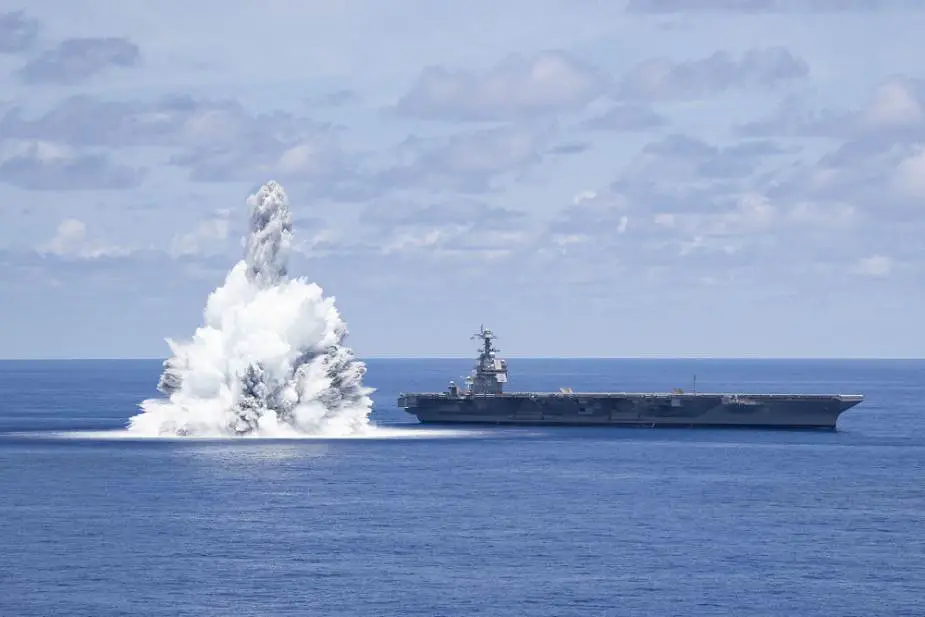According to pictures released by the United States Department of Defense, on July 16, 2021, the U.S. Navy USS Gerald R. Ford (CVN 78) aircraft carrier successfully completed the second of three scheduled explosive events for Full Ship Shock Trials (FSST).
Follow Navy Recognition on Google News at this link
 U.S. Navy USS Gerald R. Ford (CVN 78) aircraft carrier successfully completed the second of three scheduled explosive events for Full Ship Shock Trials (FSST), July 16, 2021. (Picture source U.S. Navy)
U.S. Navy USS Gerald R. Ford (CVN 78) aircraft carrier successfully completed the second of three scheduled explosive events for Full Ship Shock Trials (FSST), July 16, 2021. (Picture source U.S. Navy)
On June 18, 2021, it was announced that the U.S. Navy aircraft carrier USS Gerald R. Ford (CVN 78) successfully completed the first scheduled explosive event as part of the Full Ship Shock Trials (FSST). During the FSST, a ship undergoes three 40,000-pound explosive charge detonations which occur successively closer to the ship.
The shock trials are designed to demonstrate the ship's ability to withstand the effects of nearby underwater explosions and retain the required capability. Ford is underway in the Atlantic Ocean for the required inspections and preparation for the third FSST explosive event, scheduled for later this month.
The USS Gerald R. Ford (CVN-78) is the lead ship of her class of United States Navy aircraft carriers. She was christened in November 2013 and delivered to the U.S. Navy in May 2017 and formally commissioned in July 2021. This new American aircraft carrier is expected to leave on her first deployment around 2023 or 2024.
The Navy’s current aircraft carrier force consists of 11 CVNs (nuclear-powered aircraft carriers), including 10 Nimitz-class ships (CVNs 68 through 77) that entered service between 1975 and 2009, and one Gerald R. Ford (CVN-78) class ship that was commissioned into service on July 22, 2017.
The Gerald R. Ford (CVN-78) class carrier design is the successor to the Nimitz-class carrier design. The Ford-class design uses the basic Nimitz-class hull form but incorporates several improvements, including features permitting the ship to generate more aircraft sorties per day, more electrical power for supporting ship systems, and features permitting the ship to be operated by several hundred fewer sailors than a Nimitz-class ship, reducing 50-year life-cycle operating and support (O&S) costs for each ship by about $4 billion compared to the Nimitz-class design, the U.S. Navy estimates.
The U.S. Navy plans call for procuring at least four Ford-class carriers including CVN-78, CVN-79, CVN-80, and CVN-81. The CVN-78 (Gerald R. Ford) was procured in FY2008 (Fiscal Year). The Navy’s proposed FY2022 budget estimates the ship’s procurement cost at $13,316.5 million (i.e., about $13.3 billion) in then-year dollars. The U.S. Navy is currently working to complete construction, testing, and certification of the ship’s 11 weapons elevators.
The CVN-79 (John F. Kennedy) was procured in FY2013. The Navy’s proposed FY2022 budget estimates the ship’s procurement cost at $11,929.7million (i.e., about $11.9 billion) in then-year dollars. The ship is being built with an improved shipyard fabrication and assembly process that incorporates lessons learned from the construction of CVN-78. CVN-79 is scheduled for delivery to the U.S. Navy in June 2024.
The CVN-80 (Enterprise) was procured in FY2018. The Navy’s proposed FY2022 budget estimates the ship’s procurement cost at $12,405.5million (i.e., about $12.4 billion) in then-year dollars. The ship is scheduled for delivery to the U.S. Navy in March 2028.
The CVN-81 (Doris Miller) is treated in this article as a ship that was procured in FY2019, consistent with congressional action on the U.S. Navy’s FY2019 budget. The U.S. Navy’s FY2022 budget submission, like its FY2021 submission, shows CVN-81 as a ship that was procured in FY2020.
The CVN-80 and CVN-81 are being procured under a two-ship block buy contract that was authorized by Section 121(a)(2) of the John S. McCain National Defense Authorization Act for Fiscal Year 2019.



